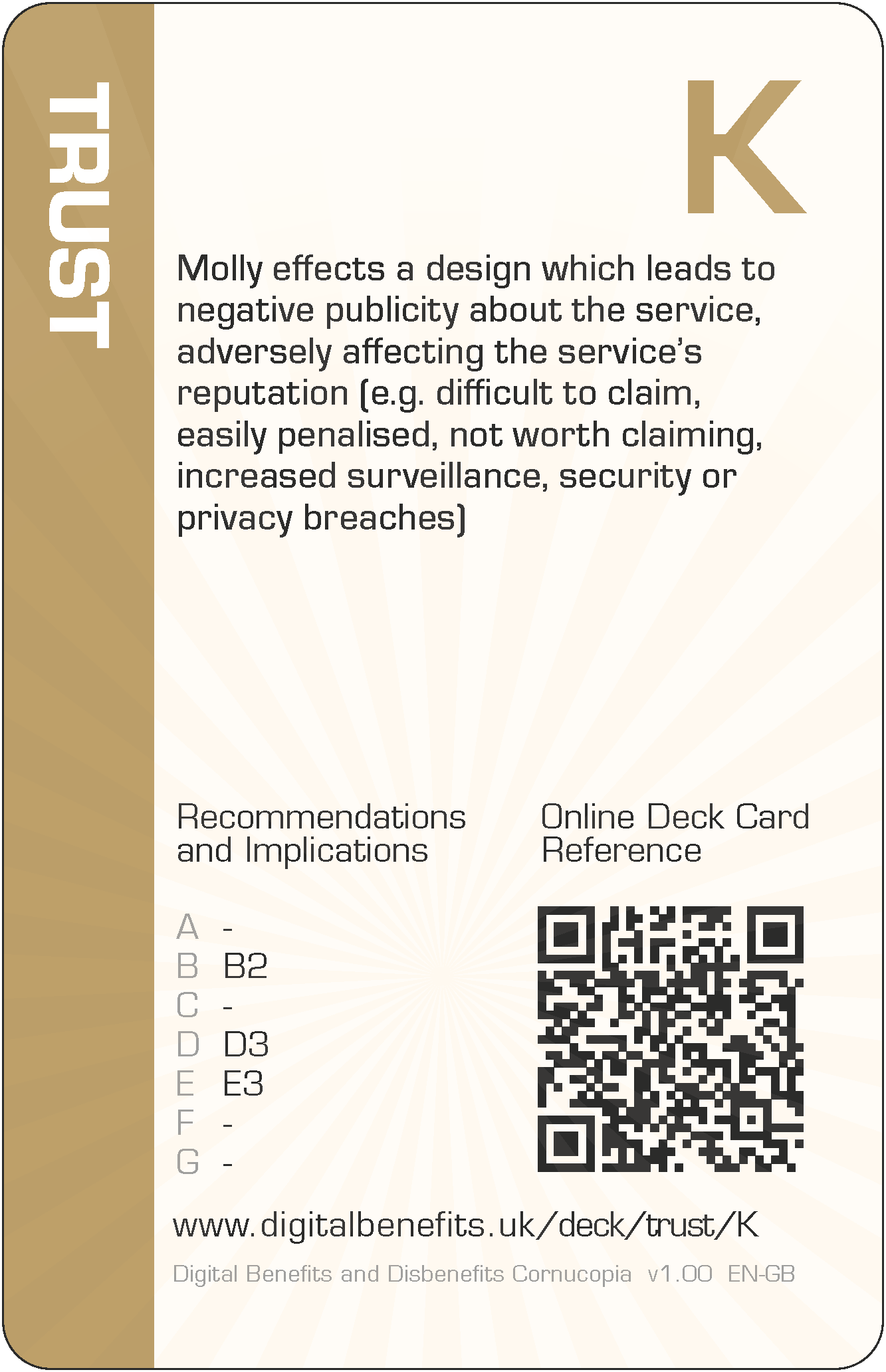Trust K (TR-K) Card
DBD Cornucopia > Deck > Trust > K
Card Details - King of Trust
Abbreviation
TR-K
Card's focus
The focus of this card is system/service reputation
Threat to claimants
Molly effects a design which leads to negative publicity about the service, adversely affecting the service's reputation (e.g. difficult to claim, easily penalised, not worth claiming, increased surveillance, security or privacy breaches)

Threat to claimants
Molly effects a design which leads to negative publicity about the service, adversely affecting the service's reputation (e.g. difficult to claim, easily penalised, not worth claiming, increased surveillance, security or privacy breaches).
Some examples of how this threat could lead to harms (negative effects on claimants)
The design recommendations and implications relevant to the card are listed below in the next section, but even those can be somewhat abstract and difficult to think about during practical day-to-day implementation. Therefore, some example harms are provided to complement the more formal research outputs. These examples are unique per card, and are only published on these web pages (i.e. in no other project outputs).
- Due to negative stories in the news, citizens are less likely to claim despite being eligible for an award
- Third sector organisations are wary of helping claimants because the negative image of the government service could rub off and affect their own organisations' reputations, putting off donors and volunteers
- Public misinformation deters people from claiming because they think the amount they will receive is not worth the effort
- Unchallenged false information, fake news, malicious disinformation, negative rhetoric and incorrect rumours mean that citizens incorrectly believe they are not entitled to the welfare benefit
The examples are to help understand the threat on the card, not to suppress thinking and innovation. Incorporating these examples exactly, or closely matching ones, should be scored down when playing DBD Cornucopia as a game.
Applicable design recommendations and implications
These are reproduced here from Research Briefing N
Acknowledge claimants as people in digital design
- Ensure system and state accountability to claimants
Equalise accountability between claimants and the state. Promote a sense of fairness by enforcing an expectation that service level standards for actions and response times should be similar to those expected of claimants, with related penalties not disproportionately, or only, affecting claimants. Provide tools/methods for claimants to easily check, query and challenge actions and decisions.
Embrace a wider ecosystem and fuller claimant activity viewpoint for digitised public services
- Use claimant-related policy outcome measures to assess digitisation
The most relevant factors of success of digital transformation are metrics based on the intended purpose of the policy rather than focusing on state-incurred financial costs. The advantages of digitised policy implementation must be balanced with the gains and harms across the whole ecosystem from the viewpoint of claimants.
Design systems which support the division of labour with claimants' ecosystems
- Recognise changing trust effects in design of digital systems
Claimants have different opinions about the trustworthiness and motivations of the state, unfamiliar claimants and other actors, which affect their tolerance to accept harms, requiring flexibility in choosing assistance and recognition how this trust can change over time: prior to making a claim, while maintaining a claim, and after ceasing to be a claimant.
General Notes
Card values (i.e. 'King' for this card) are for game play and are not correlated with the severity of harm. This is because threats cannot be ranked directly since they can affect individuals in different ways due to situations and circumstances, or affect fewer or more claimants, or the harms can arise in claimants' support networks and wider society.
The threat description uses a person's name as the "attacker" (i.e. 'Molly' for this card), which can be thought of someone involved with implementation. They could have any role which influence digitisation. So they could be a database administrator, or a copy writer, or a quality assurance specialist, etc, or all of these. Everyone could have some influence on the claimant threat described. The names were randomly selected from those currently most popular as given names for boys and girls (UK Office for National Statistics).
The example harms provided are drawn from the research data (which explored not only parts of existing services but also the effects of possible changes to those), from the author's own knowledge of web application development and testing, the author's own experience of helping citizens to claim Universal Credit (UC) and Personal Independence Payment (PIP), and from suggestions submitted by other people (make a suggestion). The threats and example harms do not necessarily exist in the current UC or PIP deployments or in ecosystems around those services, but they might well do.
All the cards in this Trust suit are: 2 3 4 5 6 7 8 9 10 J Q K A
The other suits in the deck are: Scope, Architecture, Agency, Porosity and Cornucopia (plus Jokers).
